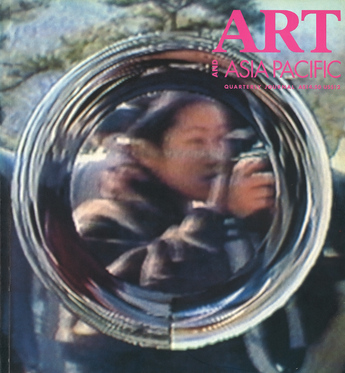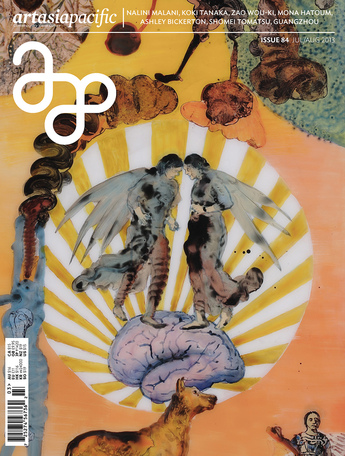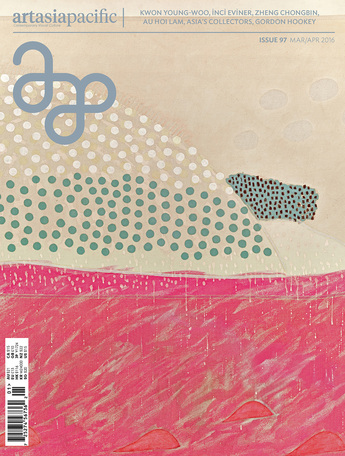
R
E
V N
E
X
T
Women Artists Speak Out: Kim Soun-gui, Pinaree Sanpitak, Wong Wai Yin, Nalini Malani, Au Hoi Lam
On October 30, a letter decrying our patriarchal society and its hegemonic power structures dictating every aspect of our lives—including the mechanisms of the art world—was circulated online. Five thousand women—artists, curators, writers and other cultural workers—signed the letter, bringing to the fore a landslide of issues regarding sexual harassment and sexism that has long been bubbling under layers of glass ceilings and nondisclosure agreements.
This world we live in is controlled by the violence of men who allow for the perpetuation of these injustices to occur, and more disturbingly, disallow—or suffocate—positive change for women.
We reached out to the many female artists featured on the cover of ArtAsiaPacific over the years, and asked them if they have ever experienced any form of sexual harassment or sexism in the workplace. They offer their statements and honest thoughts—quoted below—on what we should do to engender change, in an effort to further support the women who have bravely come forward, shattering the first barrier of silence, and to highlight the resilience of female artists. With this article, we hope to shed light on the discomfort and hostility that women artists must navigate in a society shaped by men for men, and to add to the multiple voices that are now speaking out and saying, “no more.”
This is part one of the statements; part two can be found here.
If you are an artist and would like to submit a statement, please send your words to [email protected].
KIM SOUN-GUI
Featured on the cover of ArtAsiaPacific Vol. 1. No. 4.
Yes, I experience sexual harassment, of course, in Korea, and in France also. I have developed a strong character to deal with these unpleasant events and injustices.We have to change the mentality of people, society, politics and the ethics of culture. It is essential not to submit blindness to the ethical and moral rulers of the civilizations of the past and also those of, regrettably, the current. For that purpose, it is necessary at first, to be strong.
We should not cry but must be stronger, better and make efforts to command respect.
Mutual respect is essential. This allows real freedom and harmony between women and men.
For me, I try to solve these issues and tackle the problems my own way, through my work in conducting research in art and in teaching. And I believe that I arrive there—most of the time.
Kim Soun-gui’s solo exhibition is currently on view at Arario Museum, through February 25, 2018.
PINAREE SANPITAK
Featured on the cover of ArtAsiaPacific issue 21.
In Japan, when I was 21, I was attacked but fortunately was able to control the situation. The culprit escaped. Though I was not physically raped, the incident has kept me on guard since. Making art helped—it nurtured independency. Through the diverse, faceted exploration of the female body, “the body” becomes a site for contemplation and understanding.
In my professional life, I have not experienced sexual harassment but more of a sexist attitude expressed through comments and gestures. They were not intentional, but these behaviors should not be taken for granted, and I let them know.
Pinaree Sanpitak’s artworks are currently on view at the inaugural Jakarta Biennale and in “Problem-Wisdom: Thai Art in the 1990s” at the Queensland Art Gallery, Brisbane. Her installation The House is Crumbling (2017) will be presented at the National Gallery Singapore beginning December 4, 2017.
WONG WAI YIN
Featured on the cover of ArtAsiaPacific issue 76.
A friend once told me that I was too “aggressive” as a female artist. I wasn’t sure if I was misunderstanding him because there were cultural and linguistic barriers—he’s Singaporean and had studied in England—so I asked him what he meant. He realized he might have made a misstep and so explained that he was referring to the fact that I have already achieved a lot and have left an imprint on other female artists in Hong Kong, so there was no need for me to demand too much of myself, artistically speaking.
At exhibitions overseas, I have heard people casually remark that female artists need to be the subject of gossip or scandal to become a topic of interest in the industry. I have also had art students tell me about other teachers’ claims that male artists are more suitable for creative work, and that most successful artists are men. After I gave birth, some people apparently thought that I had retired to take care of my child. On numerous occasions, discussions of female artists’ work ended with comments like “also, she is so beautiful” or “what a pity, she isn’t pretty.”
Perhaps these don’t even constitute “discussions.” They are careless comments, jokes that fall flat and boring clichés. I have no intention of criticizing the way other people think, but I am concerned about how, as women, we rarely stand up for ourselves and voice our opinions in situations like these. Often, we water down and merely touch on issues of sexism. We persuade ourselves based on the successes of a few female artists to not bring up the problem again, just so people don’t think that we are a mob of bitter, dissatisfied hags.
I am not even certain that I am fair and kind in my perceptions of myself. Sometimes, I tell myself that I am a wife and a mother—exactly what patriarchal society expects of me—so I’m not qualified to talk about women’s rights. Maybe I’m just a bad feminist. Although, thinking about it some more, the way women judge themselves and other women is just as damaging as any form of sexism. On that front, however, all women have a choice.
NALINI MALANI
Featured on the cover of ArtAsiaPacific issue 84.
The Rebellion of the Dead
As long as we are living in patriarchal societies fed by religious orthodoxy, women will experience the suppression of freedom in their professional and private lives. It is unavoidable and it kills us from within, and leaves a part of us dead. My life in India is not an exception in this, and in fact in the last decade it is even becoming considerably worse for women. From the very start, in the late 1960s, this suppression has become a recurring subject in whichever medium I have used, from 16 mm film, to photography, theater, painting or video. On an intimate or collective level, I try to shake up the public with what may look aesthetically attractive; but once into the arena of the artwork, one is confronted, as in my video/shadow play In Search of Vanished Blood at Documenta 13, where the speakers above the rotating cylinders spat into the ears of the audience.
We can only overcome this by becoming a matriarchal society, where caring, nurturing and equality are the guidelines for living. This sounds like an illusion but in fact it is the only sane choice there is if man kind wants to survive the 21st century. This is not just a matter of sexual harassment of women but extends to all female elements, including Mother Earth, to whom we owe the rebellion of the dead.
She was apprehended at 6.53 pm.
It took an hour to get her to camp.
“Make her,” He said.
Something sticky under her arse and waist.
Only the gag has been removed. Incredible thirst.
She senses that her vagina is bleeding.
How many came to make her?
Sees her breast and understands that indeed, she has
Been made up right.
Her breasts are bitten raw.
The nipples torn.
How many?*
*Draupadi by Mahasweta Devi, translated by Gayatri Spivak.
Nalini Malani’s retrospective at the Centre Pompidou, Paris, is currently on view and runs until January 8, 2018.
AU HOI LAM
Featured on the cover of ArtAsiaPacific issue 97.
A friend once told me, “If you like each other, it’s not sexual harassment. You only think it’s sexual harassment if you hate him.” I agree with this statement for the most part. I can safely say I have never been sexually harassed as an artist, and have never accosted anyone else with such behavior. For me, there is no gray area in this regard. On the other hand, the question of whether or not I’ve ever experienced sexism is harder to answer. I’ve always thought that if I were a man, I would be able to be an artist more freely and more completely—I could even just live as a person more freely. I’m not that way as a woman, not because I’m afraid of being hurt myself, but because I worry those around me will be harmed in the process. This kind of sexism victimizes both men and women and is self-imposed, as well as enforced by culture and society. The fact that I perpetuate this thinking in myself suggests that I have yet to settle my relationship with art, or maybe that I have yet to process my own gendered identity properly.
To read more of ArtAsiaPacific’s articles, including those that cover the art practices of the women artists who have shared their words here, visit our Digital Library.







